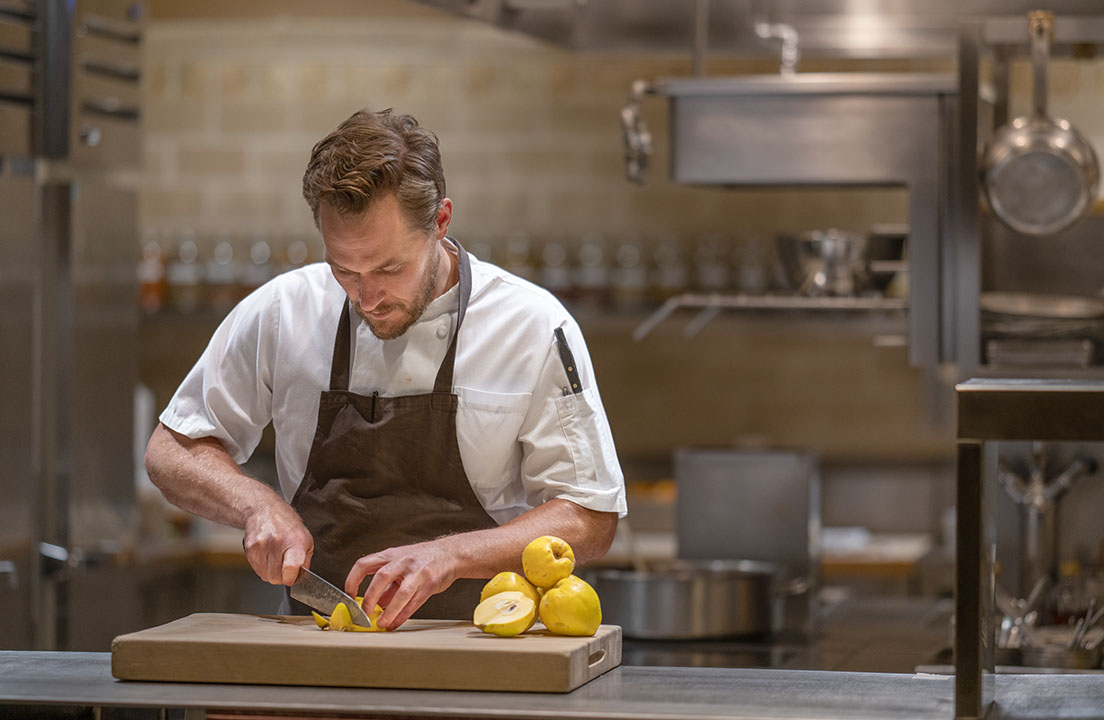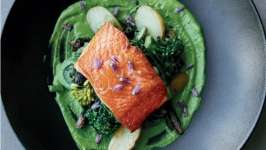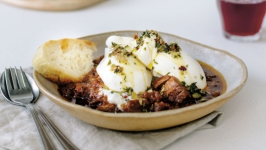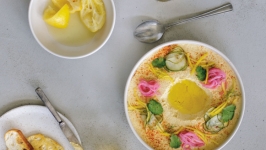The Farm Connection
Most years, Patrick Gayler would have a freezer filled with stone fruit by now, ready to bring a taste of summer sunshine to a winter day’s cheese or charcuterie plate. But not this year.
“It’s been a weird one, not having any stone fruit, not having any peaches, apricots or nectarines,” says the executive chef at Mission Hill Family Estate Winery. He adds, philosophically, “But we’ve just had more time to work with other things, like haskaps and strawberries.”
Long before the Okanagan Valley was known for wine, it was famous for tree fruits: for cherries, plums, apples and, above all, peaches. Summer is “peaches and beaches” season here. The fragrance of peach blossoms infuses Okanagan white wines the way wild thyme does the reds of the Southern Rhône. And there is no more quintessentially Okanagan experience than plucking a perfectly plump, juicy peach from a tree and eating it right there in the orchard.
It’s this perfect produce that draws chefs like Gayler to the valley. In a normal summer, he’d bring a couple thousand pounds of stone fruit into his kitchen. But in mid-January, temperatures plummeted below minus 25 C, plunging the Okanagan and Similkameen valleys into a deep freeze for days and devastating vines and fruit trees alike. And this came on the heels of another brutal cold snap in December 2022.
The result has been catastrophic. There will be no local vintage for 2024. And there has been so little fruit to sell that the 88-year-old BC Tree Fruits cooperative announced in July that it would have to cease operations, leaving its 230 farming families scrambling to get their produce to market.
“One of my favourite guys from down south, his big thing is apricots and peaches and nectarines. Ninety per cent of his crop was stone fruit, and at the market the only thing he could sell was basil plants and pepper plant seedlings,” Gayler says. “It’s tough even talking to these guys.”
As a lot of people seem to be saying these days, with a determined set to their jaw, that’s farming for you.
Making connections
Any chef worth their flaky sea salt will tell you that, without farmers, they can’t do their jobs. But that’s especially true at Mission Hill.
Back when the winery opened in 1981, high up on a hill overlooking Okanagan Lake, there were only a handful of wineries in B.C., mostly growing hybrid grapes. But owner Anthony von Mandl believed that the Okanagan could produce excellent wine and was proven right in 1994 when a 1992 Mission Hill Chardonnay was named the best in the world at the International Wine and Spirit Competition in London. Mission Hill has since earned barrels of accolades and has been named Canada’s Winery of the Year five times.
Today von Mandl’s Iconic Wineries of British Columbia comprises seven properties (including CheckMate, CedarCreek, Liquidity and Road 13), but Mission Hill is still the flagship. Senior winemaker Taylor Whelan calls it “the mother ship” and says, “Its bell tower is a beacon for the valley.”
That bell tower was part of a major redesign by the celebrated architectural firm Olson Kundig, was completed in 2002 and included one of the first winery restaurants in B.C., the 60- seat outdoor Terrace helmed by chef Michael Allemeier. One of the chef’s first tasks? Making connections with local farmers. He also planted his own herb garden and started a preserving program. Within a few years, Travel + Leisure named Terrace one of the world’s best winery restaurants.
Chef Allemeier’s approach to Terrace became the model not just for future Mission Hill chefs but for winery chefs throughout the valley, from Danny Tipper at Ex Nihilo’s Chaos Bistro in Lake Country to Roger Sleiman at Quails’ Gate just down the road to Murray McDonald at The Bear, the Fish, the Root and the Berry at Nk’Mip Cellars all the way down south in Osoyoos. It is what we think of now as B.C. wine country cuisine.
In 2014, Gayler joined the winery as executive chef, after a career that took him from Victoria’s Inn at Laurel Point to Calgary’s Catch Restaurant to international competition as a member of Culinary Team Canada (2009 to 2012). Like his predecessors, he has made it his, well, mission to work with local farmers. His motto: When the valley thrives, we thrive.
Beyond seasonality
Gayler works mainly with 10 farms up and down the valley. Among them is the tiny, two-acre Wise Earth Farm right in Kelowna, where co-owners Myles Ferber and Ariana Gagnon use regenerative practices to grow everything from salad greens and tomatoes to sweet stem cauliflower and ginger.
“We source 50 to 60 per cent of the produce for the restaurant from Wise Earth Farm,” Gayler says. “The volume they produce off that space is incredible. They’ve just created the right circumstance for things to grow really well and be amazing. We get some very cool things from them.”
Having made so many connections, he can ask farmers to grow things he wants to serve and also is among the first to hear about the interesting new things they are planting.
For instance, Unearthed Organics used to be a market farm similar to Wise Earth. But then COVID came along and, like so many of us, owner Jordan Marr pivoted. Now he specializes in legumes, chilies and milling corn, while still following regenerative practices.
“He might be the only guy in B.C. focusing on heirloom corn varieties for drying and milling. He’s also in the process of nixtamalizing his corn for tortillas,” Gayler says. “My goal is... to do pupusas. Gluten-free, vegan; it’s a great way for us to get a great dish on the menu.”
Meanwhile, the Mission Hill herb garden has continued to grow, abundant with everything from lavender to anise hyssop, and now comprises a small orchard and several beehives as well. He’s growing sea buckthorn, which he serves with melon and burrata; lime basil, which he uses in a variation on key lime pie, sour golden plums that can replace citrus in a dish; and far more chamomile than they can ever use.
Perhaps most importantly, though, he’s found ways to overcome the challenges of seasonality that make it so hard to feed people, make money and keep staff year-round, especially if you run an outdoor restaurant that’s only open four months of the year and is trying to offer a consistently elevated experience.
“We have a crop plan that our team can work with now,” he says. “We’re not flying blind. We really built that in the last year or two.”
The winter event
Still, farming, whether it’s grapes or peaches or cornmeal, is all about the seasons. There’s a time to plant, a time to prune, a time to harvest and a time to keep your fingers crossed and hope that there will be enough rain, but not too much rain, that it’ll be a hot summer, but not too hot, and that there won’t be another cold snap like the ones in 2022 and 2024.
Whelan, who had previously been the head winemaker at CedarCreek, stepped into his role at Mission Hill in January, just five days before what everyone is calling “the winter event.” He’s since been spending his time going through the company’s 50 or so vineyards, talking to viticulturalists, assessing the damage, planning for the coming years.
“The reality is that we’re looking at least at a three-year rebuild... it’s more like a three- to 10-year rebuild,” he says.
But there is some good news. First of all, he points out that a lot of wineries still have plenty of wine to sell, at least for the next two years. Secondly, devastating as the damage has been, it’s an opportunity to really decide what the future of B.C. wine should be.
“The winter event has happened. The damage is done. It’s not a great thing that happened, but it’s not often that a region has a chance to remake itself,” Whelan says.
True, Mission Hill is in a much better place to weather the storm than smaller, newer, more heavily indebted wineries or the growers they rely on. And yes, it’s going to be a hard few years — Wines of BC estimates that the financial hit to the wine industry will be somewhere in the region of $450 million.
Worse, it’s not just the winter event that has hurt the Okanagan in recent years.
There was the pandemic, the supply chain issues that followed and some of the worst wildfire seasons on record. Then there was 2021. That year, a heat dome in June saw temperatures hit 45 C in Kelowna; in September, wildfires blanketed the valley in smoke; in November, floods washed out major highways that are still not fully repaired. That was followed by the two winter events, more fires and, adding to the misery, restrictive new rules all but banning short-term rentals.
“Between that, the fires, the stone fruit and the wine, and the economy, it’s a perfect storm for people not to travel here,” Gayler says. “This year is kind of an anomaly in that all of these things just coalesced all at once. It’s just been... It’s been really, really tough.”
Preserving and planning
Then again, no one goes into farming or restaurants without a healthy supply of optimism.
It helps that the government recently gave wineries approval to buy grapes from Washington and Oregon so they can keep their people employed and have something to sell in their tasting rooms. It helps that industry leaders are investigating smart new ways of growing grapes and other crops. It helps that even though there are no peaches, it’s been a stellar year for strawberries and tomatoes.
And that’s good news as Gayler ramps up his annual preserving program.
“We do somewhere between 1,200 and 1,500 litres of jarring. And then freezing — we probably put away 600 pounds of tomatoes and berries each,” Gayler says. He figures his team puts up 2,000 to 2,500 kilos of canned and frozen produce each year.
“That’s been huge because that’s part of our crop planning. So we are able to open the season with a tomato and asparagus dish,” he says. “It’s nice, too, because this time of year we can get whatever we want, but between April and May there’s pretty slim pickings. Being able to pull something out of the freezer or out of a jar just gives you that extra element.”
They also process eight to 10 whole pigs and a couple of hundred pounds of beef each year. The charcuterie program started as both a passion project and way to keep some of their sous chefs on after the season ended; now, the season doesn’t really end.
All winter they offer cooking classes that have been such a hit that about half the people who attend are repeat customers. “If they come once, they’ll be back because they love it,” Gayler says. “It’s the entertainment of it and the style of food they like to eat. We have the image of being elevated, but people come in and within 20 minutes they are laughing and having fun.”
He is also planning to continue serving meals year round, maybe even opening up the visitors’ hall and offering à la carte lunches and dinners designed for the colder weather. “We’re looking to build a little more familiarity and approachability in the menus,” he says. “The whole idea is we want people to be able to come in for lunch on a Tuesday or a Wednesday for a bite to eat and a glass of wine.”
After all, as the last few years have shown, “You can’t tie your vineyard into one small thing anymore because the weather is so volatile,” Gayler says. “We should be able to grow our winter business so we’re not so reliant on the summer months.”
Mission Hill Family Estate
1730 Mission Hill Rd., West Kelowna
missionhillwinery.com | @ missionhillwinery














